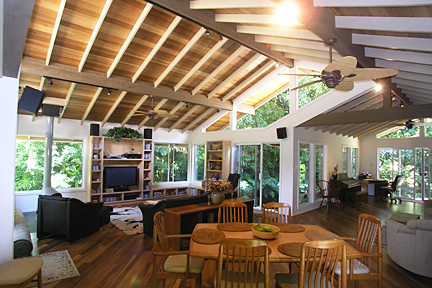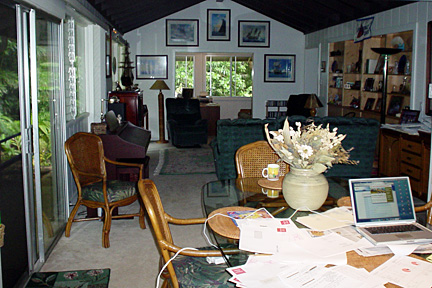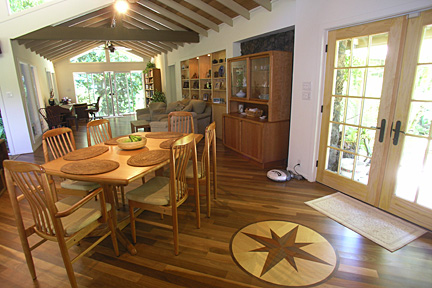
A renovation of the Harrison home in Nuuanu joined the living room and an unused lanai in creating a great room with high ceilings and windows that opened the interior to trees and mountain views. The roofline was important in preventing the lanai area at left from looking like an add-on. Before view, below.
At home with nature
A Nuuanu couple redo their house
with the environment in mind
anne Harrison remembers the date, Sept. 27, that work started on the renovation of the Nuuanu home she shares with her husband, John.
"It was nine months, almost to the day that they finished the bathroom."
Nuuanu OasisArchitectural team: Paul Noborikawa, AIA, and Nathan Iwamasa of ADI Design Group Inc.Interior designer: Trixie Ballesteros, Associate ASID, ADI Design Group Inc. Structural engineer: Randal S. Furomoto & Associates General contractor: Greg Thielen, Complete Construction Services Existing interior: 1,745 square feet New family room: 280 square feet New studio with bath: 200 square feet
|
According to project architect Paul Noborikawa, the 1954 home was not built to take advantage of the site. The ceilings were low and windows were small, creating a dark, claustrophobic atmosphere. An open patio with a rusting corrugated roof offered extra square footage but was unusable because of all the mosquitos in the rainy neighborhood.
On the plus side, the bathroom and master bedroom had been renovated prior to John Harrison's purchase of the home in 2000.
That was long before the real estate market started heating up and interest rates dropped, so that the work suddenly made financial sense, even at $444,000. That was double the cost of initial plans because the couple kept adding on new projects, such as converting an old, unused furo and laundry room into a guest bedroom, redoing the floors, adding a concrete driveway and reconfiguring an existing carport to best accommodate photovoltaic panels.
"Along the way we just thought that we should get it all done at once," John said. "We didn't want to do it again. And the property value -- even though it's inflated now -- exceeds what we have in it."

An old furo area is shown before construction, above, and after its conversion into a guest bedroom, complete with bathroom, below.
Clear glass windows and sliding doors opened the home to the outdoors and "met our objective of bringing in lots of light," John said.
Windows on both ends of the roof line now frame the mountains of Nuuanu and Pacific Heights. "So now we have the presence of being in the valley, as well as being in the rain forest. We can see the moon coming up over the ridge, and from any window you can look out and all you can see is forest. There's no sense of any houses around you."
Going beyond the home's inviting tranquility, John, environmental coordinator for the University of Hawaii Environmental Center, is hoping the home will be an example of eco-friendly practices. It includes practical and energy-saving features, such as roof insulation and roof ridge vents that create convective circulation, allowing heat to escape and eliminating the need for air conditioning.
John has been envisioning this home his whole life. Beyond the basic creature comforts that people want in a home are some lofty ideals.
"I grew up on a farm in Vermont, which was formative in my awareness of ecology and natural cycles," he said. "Hawaii, as an island in the middle of the Pacific, is an ideal place to recognize self-sufficient practices because it's at the end of a long and rather precarious pipeline to sustaining our needs, particularly when it comes to energy."
Residents are already feeling the pinch now that the rising cost of oil has resulted in higher gasoline prices. Even without the current conflict in the Middle East and the crippling of Gulf Coast oil supplies due to Hurricane Katrina, the situation was bound to get worse. Many futurists, at their most optimistic, are predicting Earth's fossil fuel supply will run out in 50 years. Author Paul Roberts, in "The End of Oil: On the Edge of a Perilous New World," says, "Within 30 years, the world will have used up all the oil that is readily accessible."
That might sound scary but John is upbeat. "We have more renewable energy resources available to us than other places around the world."

One of the touches that added to project cost was the addition of a compass design in five different hardwoods, indicating true north. Homeowner John Harrison said, "As a sailor it was very important to me, and it reinforces a sense of place."
"We'll be off the grid and, hopefully, be pumping energy into the grid," John said. "Upper Nuuanu is not a prime area for renewable energy (because of cloud cover and rainfall), but if we can demonstrate it's doable here, then people have no excuse."
For the typical family, the cost of installing solar panels is prohibitive, representing the cost of two cars, but the former represents a commitment to a better future; the latter, a gas-guzzling downward spiral.
Again, John is optimistic. "What I can develop and actualize here can serve as a model for the rest of the world because government can't do everything for us. There needs to be a lot of individual commitment."
In reference to current struggles in Iraq, he said, "Displacement of oil imports can play a very big role nationwide and internationally.
"It's gonna take time, but as with so many other things, awareness is conveyed by changes that people are unhappy with, and gas prices reaching $3.50 or $4 a gallon would go a long way toward driving home the point," he said weeks ago, when prices were still well below $3 and no one expected the Hurricane Katrina crisis.
ANNE, A second-grade teacher at Hokulani Elementary School, is relieved that their sacrifices paid off. For nine months the couple camped in their kitchen and bedroom wing with two of their teenage children because they didn't see the point of spending more money to rent elsewhere during the renovation.
"If we didn't have a kitchen, we probably would have moved out, but because we did, I said, 'We can do this.' Then after a few months I thought, 'OK, maybe we should have moved out,' because it was not fun."
The benefit of being on site, John said, was that "it was very instructive to be here the whole time. I don't have much experience with building houses, but I've worked with boats most of my life. I just looked at this as a boat-building project with a lot of right angles.
"I don't think it would have turned out the way it did if we weren't on site. Every day, there were a myriad of decisions that had to be made.
"Now I know where everything is. I took pictures of everything. I know where all the studs are; I know exactly where to drill holes for needed wiring. I know how everything's put together."
But now that the work is complete on his home, as well as on his 32-foot sailboat, John is at a loss for another project.
"Annie is worried," he said.
"I'm happy being at peace," she said, "but he'll think of something to do."
E-mail to Features Desk
[News] [Business] [Features] [Sports] [Editorial] [Do It Electric!]
[Classified Ads] [Search] [Subscribe] [Info] [Letter to Editor]
[Feedback]
